Roaring through the Twenties: 1920 - 1930
The “Roaring Twenties” commenced with a true roar both for Denison and for Gamma-Xi. The fall 1920 chapter letter said, “Denison opened with the largest enrollment in its history, and 24 Gamma-Xi men returned early for rush season. As a result of our efforts five Class of ’24 men are now wearing the Caduceus.” Kappa Sigma was well represented on the Big Red football squad by six brothers.

A fall party on the lawn, the first annual Fathers’ Day celebration—where sufficient funds were given to purchase a new five-piece furniture suite for the front room—and Homecoming, with the return of many alumni, highlighted the fall calendar.
After acquiring one more pledge, all six were initiated in February. Under the leadership of captain John W. Ehrle ’21, the Denison varsity basketball team was doing well and was definitely a contender for the conference championship.
As reported in a winter chapter letter: “‘Her athletes, too, bring fame to Gamma-Xi.’ These words from the old familiar tune have again been fulfilled, as the speedy Gamma-Xi basketball five won the interfraternity championship from the Betas, 8-5, in a hard and fast game.” While the varsity basketball team dropped three games, finishing with a .727 average in the conference, it came back to beat all three of the teams it had earlier lost to in return games and giving two of these their only defeat of the season. The Big Red also beat the Ohio State team by a 36-32 score! Finally, in a post-season invitation tournament of the Allegheny Mountain Association in Cincinnati, Captain Ehrle’s team copped the championship.
A spring chapter letter announced that one-third of the chapter was in the Denison glee club. These were the years when Gamma-Xi became known as “the singing chapter.”

The letter also reported that Gamma-Xi was practically controlling student government that year, with John Ehrle as president, Lawrence E. Smith ʼ22 as treasurer, Edward M. “Ned” Steadman ʼ23 as secretary, and Gordon D. “Pinky” Hamel ʼ22 as senior representative. The annual alumni letter urged many to return in June for the usual banquet. It was expected that some definite steps would be taken at that time toward establishing a new chapter house fund.
The first fall chapter letter of 1921 showed that only 15 brothers returned to Denison, but that eleven new pledges had been acquired—the largest class on campus among the national fraternities.
With four brothers now on the varsity football team, the new athletic field, a gift of Colonel Deeds and not yet fully completed, saw its first game on October first. Unfortunately, the Big Red lost to Butler College of Indiana 19-6.
The next chapter letter noted that Gamma-Xi was fortunate to claim two new members of the faculty, D. Sterling “Abe” Abel ’20, an instructor in physics and engineering, and Thomas F. McMahon ’20, as an assistant coach. Denison’s second annual Dad’s Day was a success, proving its value and a permanent place on the college calendar.
Clarke Olney ʼ22 had the lead in the Masquers’
production ofThe Importance of Being Earnest in December. In musical activities Gamma-Xi was again strong, placing six men on the glee club squad, led by Donald R. Fitch ʼ22.
A spring chapter letter reported the initiation of nine men on February 25, bringing the chapter to a strength of 23. “The ceremony was one of the most impressive of recent years, as all the Initiatory and Explanatory Lecture were given from memory.” The annual initiation banquet, with eleven alumni present, followed the ceremonies.
After a disappointing Big Red basketball season, the alumni game between the varsity and ex-Denison captains displayed quite a galaxy of Kappa Sigma stars. Livingstone T. Steadman ʼ24 did good work for the varsity, while Lester J. Black ’14, Emerald B. “Bubby” Wilson ’18, and Thomas A. Cook ’19 were easily the featured performers for the alumni. The old grads won 32-31, but not without a real scrap!
The spring dance was attended by with 20 couples. The music was provided by Norton H. Gilbert ’25 and his Green Imps.
Among those elected to Phi Beta Kappa that spring were senior Don Fitch and junior Albert T. Helbing ʼ23.
Many grads returned on June 10 for the annual alumni banquet, where plans for a new chapter house were discussed, closing a successful school year.
Kappa Sigmas generally and particularly members of Gamma-Xi Chapter were especially pleased and proud to learn that June that W. Geer “Bunny” Spencer ’07 had been selected as president of Hillsdale College in Hillsdale, Michigan. An article in The Caduceus announced that he would assume the presidency in September and quoted the Hillsdale College announcement: “President Spencer is a robust, buoyant, and affable man of 35 years. His father has during nearly all this son’s life been a professor in Denison University at Granville, Ohio, from whose academy and collegiate courses William graduated. Thirteen years after his graduation from the college were spent in the faculties of the academies and universities of Denison and of Colgate University at Hamilton, New York. For the past three years he has been in the faculty of Franklin College, Franklin, Indiana.” Spencer would serve eleven years as Hillsdale’s president.
The Caduceus had earlier published an article by Spencer and described him: “He is president of one of the very liveliest chapter alumni associations in the whole fraternity; his name stands near the top of the list of givers to the house fund; all the boys of Gamma-Xi chapter know him.”
Sixteen men returned to Denison in the fall of 1922-1923 and found the house in better shape. The downstairs had been newly papered, new rugs were in two of the rooms, and the house had been completely equipped with electric light fixtures, for Granville had connected with the Ohio Power Company that spring. Rush resulted in the pledging of twelve freshmen—as the fall chapter letter reported, “the best looking group of preps in the university, as some girls were heard to remark after the season.” Four brothers were on the varsity football team, and four were in the glee club. Miles W. Levering ʼ23 was drum major for the fourth year, and Ned Steadman was serving as president of the Pan-Hellenic Council.
Homecoming 1922 was celebrated with a 10-0 football victory over Wooster and the laying of the cornerstone of Swasey Chapel. Twenty-two alumni of Gamma-Xi returned for the day—more than had been there for years.
The winter chapter letter said, “Gamma-Xi is proud of her upward climb in scholastic standing for the first semester and hopes to do even better in the second.” The chapter initiated all its pledges on February 25th. “Our social life has been lively, with many well-arranged house stunts, one of them being a musicale to celebrate the arrival of our new baby grand Baldwin piano.”
During the year the brothers were active in theatrical and musical groups. The Denison basketball team was the champion of the Ohio Conference, with Livy Steadman and Vernon L. Springer ’25 on the squad. Springer was the second highest man on the team in number of field goals, and then went on to secure a regular place on the baseball team.
The 1923-1924 school year commenced with the pledging of 14 men, 12 of whom were freshmen.
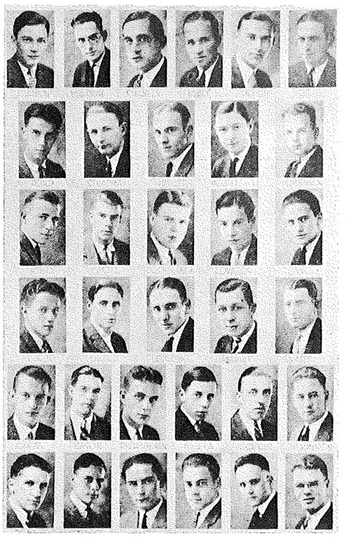
Gamma-Xi had a firm grip on the school band with Nort Gilbert as drum major, Don Fitch as director, Frederick R. Moore ’25 as manager, and Eugene H. Hanhart ’27 as an instrument player. Fitch had returned to Granville after graduate studies and had been appointed alumni secretary for Doane Academy.
The new chapel, donated by and named for Ambrose Swasey, was nearing completion. Several of the brothers spent their summer working on the project. Before 1914, a third-floor room in the Doane Academy Hall, which could seat 500, served daily chapel, but between 1914 and 1923, Denison used the Baptist church in the village.
Discussion continued on the need for a larger chapter house as Gamma-Xi grew. Homecoming, November 10, 1923, brought a large turnout of alumni to discuss the options. The decision, as reported in the February 1924 issue of The Caduceus, was a plan to erect a new home. The chapter hoped to raise enough to build a chapter house for between $40,000 and $50,000. Alumnus Advisor Don Fitch was coordinating the fund raising.

The chapter letter in the same Caduceusissue reported that Livy Steadman had been elected football captain for 1924.
Ten men were initiated into Kappa Sigma on February 23. Gamma-Xi won the intramural basketball championship that year with a quintet headed by Steadman. Plans for “the biggest and best reunion ever” at commencement time were made, and William O. Greene ’11 promised to bring back 50 of the oldest alumni “even if I have to pay some of their fares myself.” Unfortunately, no report on the success of these plans survives.
Eight men were pledged in the fall of 1924, and the chapter “is as large this year as ever before,” the December chapter letter reported. It also noted with pride that eight brothers were on the varsity football squad, including Captain Steadman. The chapter was striving for higher scholarship attainment, though it ranked well toward the top the previous semester.
The March chapter letter reported that Denison had to shut down for two weeks during the winter due to the breakdown of the college heating plant. This caused a delay in the start of the second semester.
The basketball season continued, however, led by Lawrence F. Richardson ’25. Larry was the high-point man on the Big Red team and ranked among the first ten in the conference.
Donald A. Leslie ʼ26 and George R. Stibitz ’26 were elected to Phi Beta Kappa in their junior years. Harold A. James ’26 was elected president of the Denison student government, and Leslie was appointed editor-in-chief of The Denisonian. Lloyd D. France ’26 was captain of the varsity baseball team. Many other brothers were active in spring sports, the glee club, and theater.
As the school year ended, Gamma-Xi could count 197 initiates on its chapter roll. Five brothers from other chapters had affiliated with Gamma-Xi since 1911.
The fall of 1925 commenced with the pledging of seven men. The chapter was handicapped in numbers with only 21 actives, but was still strong.
Gamma-Xi had four men on the varsity football team, Paul A. Rutherford ʼ25, E. Mendel Shanley ʼ27, David S. Evans ’28, and pledge O. William Moore ’28. Four of the pledges were on the freshman squad, Mitchell O. Gregory ’29, Joseph G. Rose ’29, Paul R. Homberger ’29, and Theodore G. Leslie ’29.
As for the chapter’s scholarship, Kappa Sigma topped the university list for the second consecutive time.
That fall, ground was broken by the University for a new fraternity row on a ridge north of the main campus. There were hopes that Kappa Sigma could join Sigma Chi, Beta Theta Pi, and Phi Gamma Delta in the project, but raising the $45,000 needed was going to be quite a challenge.
The oldest known copy of a newsletter of Gamma-Xi Chapter is in the chapter archives of Kappa Sigma International Headquarters in Charlottesville, Virginia. The Gamma-Xi archives consist of two oversized three-ring notebooks with archival plastic sleeves containing most of the documents on file at Headquarters relating to the chapter. Included first are the early letters from 1909 to 1911 regarding the petition of Beta Alpha Delta and the installation plans, as described in Chapters 2 and 3 of this book. The next oldest item preserved is a copy of The Gamma-Xi Bulletin dated February 3, 1926.
This three-page, mimeographed document first urged the alumni to return on February 20 for initiation, a big banquet, and a serenade. The eight pledges were profiled, among them: “Mitchell O. Gregory ’29, from Fayetteville, North Carolina, has two worthy aspirations, varsity football and state champion in the shot put. ‘Mike’ was elected captain of the freshman football team and will make a strong bid for regular fullback next season. He is one of the best known freshmen on the campus.” Mike would go on to become one of Denison’s most prominent alumni and an icon of Gamma-Xi Chapter of Kappa Sigma.
The newsletter also reported, “The actives have come across 100% on the subscriptions for bonds for the new house; have you signed yours yet?” Among chapter activities, Harold James was president of the student government, Don Leslie was editor of The Denisonian and president of Masquers.
In the basketball season, Nelson E. Grube ʼ28 represented Gamma-Xi on the varsity team and Gregory, Rose, Homberger, and Ted Leslie were on the freshman squad.
In the spring, Orville L. Beardsley ʼ28 was elected editor-in-chief of The Adytum, and was also named sports editor of The Denisonian.
Seven members of the chapter were active in theater. Garland F. Hick ʼ28 had the leading role in Shaw’s Candida. He was the son of Beta Alpha Delta founder Hugh R. Hick ’03 and later changed his name to “Hicks.”
On May 14 and 15, Gamma-Xi sent an initiation team of ten men to Columbus to assist Alpha-Sigma Chapter at Ohio State in the installation of Delta-Kappa Chapter at Ohio Wesleyan University in Delaware. Forty-five undergraduate and alumni members of Theta Delta Psi local fraternity, founded in 1922, were initiated. Kappa Sigma Historian and Past Worthy Grand Master Finis K. Farr, who had installed Gamma-Xi Chapter in 1911, returned to central Ohio to install Delta-Kappa.
The 1926-1927 school year commenced with the pledging of 16 new prospective brothers, 11 of whom tried out for the freshman football team and seven making the first team. Sophomores Mike Gregory and Joe Rose won regular berths on the Big Red varsity football team. Gregory was an All-Ohio selection.
The chapter stressed scholarship during the fall semester with the result that it was able to initiate the entire pledge class on February 12. L. Andre Odebrecht ʼ28 was elected to Phi Beta Kappa in his junior year.
Twenty-two brothers returned to Granville for the fall 1927 semester. Thirteen others had graduated in June or did not continue at Denison. Nine new men were pledged.
Sketches and plans for the new chapter house on Fraternity Row were being reviewed by the chapter. The house on Shepardson Court was insufficient for the chapter’s needs and not in good shape.
Nearly half of the active chapter went out for varsity football. Gregory, Rose, Richard M. DeMay ʼ28, and Homberger were veterans who stepped back into their old positions. The chapter proudly displayed a wall plaque, recognizing its fourth annual championship of intramural volleyball.
Garland Hick was editor of the weekly Denisonian and Ted Leslie was business manager of The Adytum.
Kappa Sigma had the best representation of alumni back for Homecoming of any of the Greeks that fall, due probably to the personal invitation letters written by the undergraduates to the alumni. Despite the efforts of Brothers Gregory, Rose, DeMay, Homberger, and John F. Larimer ʼ30, the Big Red lost its Homecoming game to Ohio Wesleyan. Harold James was again captain of the cross-country team.
The new chapter house fund was growing, with the hope that Kappa Sigma would soon be represented on the new Fraternity Row. Grand Master Orville Beardsley made a state-wide tour of Ohio and visited nearly all of the chapter’s Ohio alumni. He raised one-third of the needed money.
Nine pledges were initiated on February 11 at the Granville Inn, the ritualistic work being performed by undergraduate and alumni teams, alternating. Because it took place near the 25th anniversary of the founding of Beta Alpha Delta , many alumni, especially the “old-timers,” were back. For the Explanatory Lecture, the new illustrative slides were used for the first time by Gamma-Xi.
Following a reception for the new initiates, a banquet was served in the ballroom to more than 100 guests, including brothers from the other Ohio chapters.
The March 1928 chapter letter reported, “Each day the proposed new house becomes more of a reality with cash and pledges coming in.”
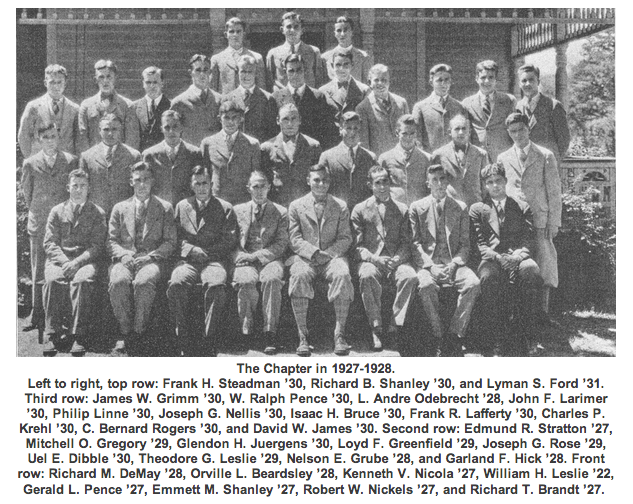
The chapter was functioning with smoothness due to the ambition of the undergraduates and the backing and advice of the alumni. With a complete address list, the chapter was sending each alumnus a communication every two weeks.
At the June 1928 commencement meeting of the alumni, an important decision was made. Kappa Sigma would raise the necessary funds to build a new home on the Fraternity Row. Then in the fall, a handsome ten-page brochure was sent to all Gamma-Xi alumni, announcing the plan to build a new home for the chapter. It summarized the quarter century of Beta Alpha Delta and Kappa Sigma at Denison:
The years have but added to the rich sentiment of that original brotherhood. Men have continued to come to the beautiful little village to get inspiration for their tomorrows and, in the environment of friendliness, to learn of the fundamentals for their lives in the business of the world. Our chapter has come into a new age at Denison and we, as her constituency and providers must keep her abreast of the times. Our brothers, as true today as the founders of yesterday, call for aid. We are living in today and today there is a need for a new Kappa Sigma house.
It will be our purpose here to make but one statement regarding the high standing of Kappa Sigma at Denison. In scholarship, activities, athletics, and in general tone, our chapter is second to none. But men do react to environment. The environment at our house, physically speaking, is intolerable.
It was certainly not apparent from the many chapter letters previously enumerated that the chapter house had not kept up with the needs of the chapter. New furniture, rugs, and wallpaper had helped, but now the reality of a deteriorating building had been acknowledged with alarm and great concern. The status of all of the other Denison fraternities was described. Sigma Chi, Beta Theta Pi, Phi Gamma Delta, and Phi Delta Theta—younger than Kappa Sigma—had either built on the hill or were ready to do so. The appeal continued:
Can our men compete in general cultural tone with worthy contemporaries whose alumni have provided for them sufficiently on a sporting basis? Kappa Sigma’s house provision is the worst on the campus. When our present house was obtained, it was credible enough. [But now] our living condition at Granville is intolerable. Our chapter cannot continue to get men of the high standard required if our performance isn’t creditable enough to command the respect of prospective members. The challenge lies open. We must build—now. And there’s no word “fail” in the vocabulary of a true and loyal Kappa Sigma.
The Committee for New Home, composed of Charles F. Burke ’04, “Bunny” Spencer, Phil S. Bradford, Elsor Heater ’08, Earl H. Foote ’09, William Greene, and chapter Grand Master Orville Beardsley had engaged an architect to draw preliminary sketches and plans. The building contemplated was of Italian design, with a modified exterior to conform to environment and precedent in buildings already erected and also to reflect Kappa Sigma’s Italian heritage.
The ground floor featured a dining room, a kitchen, a den, and a chapter hall “accurately designed for Kappa Sigma meetings.” The main floor included a huge lounge, a library, a trophy room, a guest room, a housemother’s room, and a ladies’ room. The top floor included 17 study-sleeping rooms and a large bathroom. A large circular staircase connected all three floors.
The house committee picked a half-acre lot overlooking the beautiful Licking Hills situated adjacent to the new Beta Theta Pi house and across from the Phi Gamma Delta house, ready to begin construction.
The cost of the new house was to be $50,000. Denison University would lease the lot to the Gamma-Xi Alumni Association for $1 per year under a 99-year lease, renewable indefinitely, and would loan the Association $20,000, to be paid off over twelve years. But raising the other $30,000 was daunting. The financial statement for the project included an item, “from old Beta Alpha Delta group, $15,000.” It is not clear whether this was cash or the anticipated proceeds from selling the Shephardson Court house, but probably both. As of September 25, 1928, $3,300 was in hand from fully paid pledges. Of the partially paid pledges, $644 had been collected and $1,781 was due. Promissory notes totaled $5,430. Undergraduate notes, $25 per year for the first four years after graduation, would bring in an estimated $2,475. Other sources totaled $1,370.
The brochure urged the alumni to pay their pledges and notes now so that the contract with the university could be completed.
Sixty-five percent of our chapter have to date accounted for more than $40,000 [in cash and pledges]toward our goal of $50,000. It remains the problem of your house committee to convert promises of the 65 percent into cash, where this hasn’t been done, and it is the further problem of your house committee to get an additional $10,000 from the 35 percent of the alumni who have not yet responded. Much of the money counted upon in the statement, as from graduates who signed notes for $25 per year, are not collectable at once, since many are in graduate schools. Those in business must make the sacrifice now.
We have attempted to show you how your fraternity is worthy of your pride, both in its beginnings and its today. We have tried to explain, though all too unforcibly, the extreme need for a new house, now.
The strength of your fraternity is men. Be a strong Kappa Sigma—a part of her strength—cheer the brother who has worked hard and gratuitously, that the house may go up now, with your cooperation; think it over—decide your part—and then just do your best for your fraternity.
The 1928-1929 school year got off to a good start with the pledging of ten new men. Mike Gregory was again captain of the varsity football team, which included nine other Kappa Sigmas.
Homecoming saw Gamma-Xi’s alumni return in greater numbers than ever before, the total exceeding every other national fraternity on campus. New house talk was plentiful, and it was hoped that by February, all details would have been completed and work commenced shortly thereafter.
Philip Linne ʼ30 was editor of The Adytum that year with five brothers and three pledges on the staff.

Mike Gregory closed his Denison football career by being named to the All-Ohio team for a third year. As captain of football for the past two years, he presided at the annual football banquet at which he, Rose, Frank N. Steadman ʼ30, Lambert M. Meidinger ʼ30, W. Ralph Pence ʼ30, and Russell S. Geil ʼ31 were awarded letters. In addition, Kappa Sigma was presented with the campus intramural trophy for the prior year.
As the varsity basketball season approached, Gamma-Xi was ready with Homberger, C. Bernard Rogers ʼ30, Geil, and Steadman.
Five men were initiated on February 23, 1928, including Phil Bradford, one of the 11 members of Beta Alpha Delta who had not yet been initiated into Kappa Sigma.
Later, Phil Linne was elected president of the senior class and also elected editor of The Denisonianfor a second year. James F. Wible ʼ31 then replaced Linne as editor of The Adytum.
For the second year in a row, Kappa Sigma won the overall intramural trophy.
At the commencement meeting of the undergraduates and the alumni in June, 1929, the plans for building a new chapter house on Fraternity Row were not doing as well as they needed to. While no details survive, the amount raised was falling short of what was needed to build a new house. But then, another opportunity surfaced. Phi Gamma Delta was building its new home on Fraternity Row and would move in the summer of 1930, leaving its chapter house on Broadway available.
It was quite a house! Built in 1842 by Alfred Avery for his family, it was based on designs by famed Greek Revival architect Minard Lefever. Resplendent with four huge central Ionic columns, balanced with twin wings bearing Doric columns, and accented with two Corinthian columns at the front entrance, it was one of the best examples of Greek Revival Architecture in America.
 It had served as a private residence for the Avery family until 1845, when the Spelman family purchased it. The Downer and Cole families owned from 1873 to 1902, when it was sold to Phi Gamma Delta.
It had served as a private residence for the Avery family until 1845, when the Spelman family purchased it. The Downer and Cole families owned from 1873 to 1902, when it was sold to Phi Gamma Delta.
The chapter decided that rather than continue to try to raise funds for a new house on the hill, a project that might have taken several years or more, it would purchase the Broadway house. Even then, the purchase price plus the cost of the needed improvements exceeded the available funds. However, Beta Alpha Delta founder Charlie Burke generously provided enough additional money to make the purchase and improvements possible.
Kappa Sigma purchased the home in June of 1929, giving the Phi Gams one year to complete their new home and turn possession of the Avery-Downer House over to Kappa Sigma. Then the improvements could be made over the summer and Gamma-Xi could move in the following September.
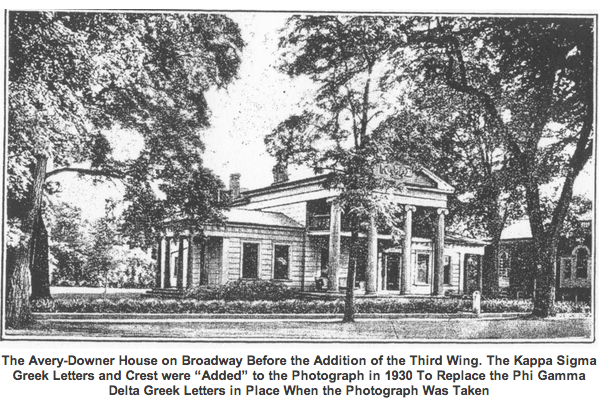
In the fall of 1929 there were big changes in the chapter, especially in Kappa Sigma presence in varsity football, for Gregory, Ted Leslie, and Rose had graduated, and Homberger did not return; three others had also graduated. Even with these losses, the chapter roll that fall was 25. Extensive summer rushing in 1929 showed real results that fall, with 14 new pledges taken during the first week of school.
Gamma-Xi was still able to boast of half the regulars on the varsity football team; seven brothers made the trip to Annapolis and played against Navy.
With a chance to win the intramural trophy for the third consecutive year and come into its permanent possession, every man in the chapter not out for varsity athletics took part in intramurals that year.
It was indeed fortunate for Gamma-Xi that the purchase of the Avery-Downer House had been completed that summer.
October 29, 1929, “Black Tuesday,” was a day that first affected the United States and soon the world when the American stock market crashed, leading to the Great Depression of the 1930s. For many, it was not a sudden total collapse, but a gradual decline. The economy hit bottom in March 1933, and the Depression really did not end until World War II.
A “hard-times” dance was held at the chapter house on January 17. Frank Steadman and Henry O. Gleiss ’30 represented Kappa Sigma on the varsity basketball team in 1930. Gamma-Xi was again in the lead for the intramural athletic honors, winning the championship in both “A” and “B” basketball leagues.
The first semester scholarship ranking was not one to brag about, with Kappa Sigma falling to fourth place among the fraternities.
Frank Steadman sank the winning goal in Denison’s big win over Ohio Wesleyan on February 19; as a result of the victory the college president suspended classes for the following day. With school spirit riding high, nine new brothers were initiated on February 22.
With the approach of spring intramural sports, Kappa Sigma found itself 40 points ahead of its rivals in the race for the all-intramural sport trophy, awarded each year by the college.
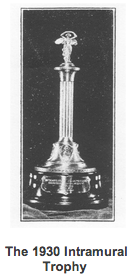
A busy summer of rushing was being looked forward to as a result of new rules—the only restriction was that no man be pledged before he has graduated from high school.
There was jubilation at the Kappa Sigma house when the intramural season ended, for the chapter had won the championship for the third straight year. This entitled Gamma-Xi to keep the beautiful trophy permanently.
An article in the October 1930 issue of The Caduceus reported that Gamma-Xi piled up 884½ points to lead its nearest competitors by 158 points and pictured the graceful trophy.
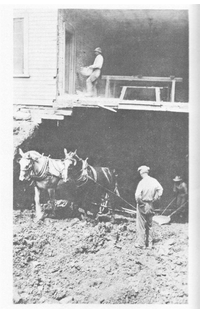
As the last year at the chapter house on Shepardson Court came to a close, the brothers watched as Phi Gamma Delta moved out of the Avery-Downer House and into its new home on Fraternity Row. Kappa Sigma soon took possession of the Broadway property and began its remodeling project.
The beautiful new home had inadequate space for a dining room, and so a third wing was added toward the rear, carefully matching the classical architecture of the original two. The plans for this addition provided a unique bonus: a special room was constructed below the dining room to serve as a chapter room.
A team of horses strained for days during the summer of 1930, digging deep for the foundation of the addition, and when completed, a spacious dining room and the chapter room below with its 11-foot ceiling constituted Kappa Sigma’s contribution to the architecture of the Avery-Downer House.
As the decade closed, a new era for Kappa Sigma at Denison lay just ahead. In its first twenty years Gamma-Xi had grown from a local fraternity to a strong national one, with outstanding athletes and scholars, a very strong alumni association, and a chapter roll that had reached 251 initiates and seven affiliates.
